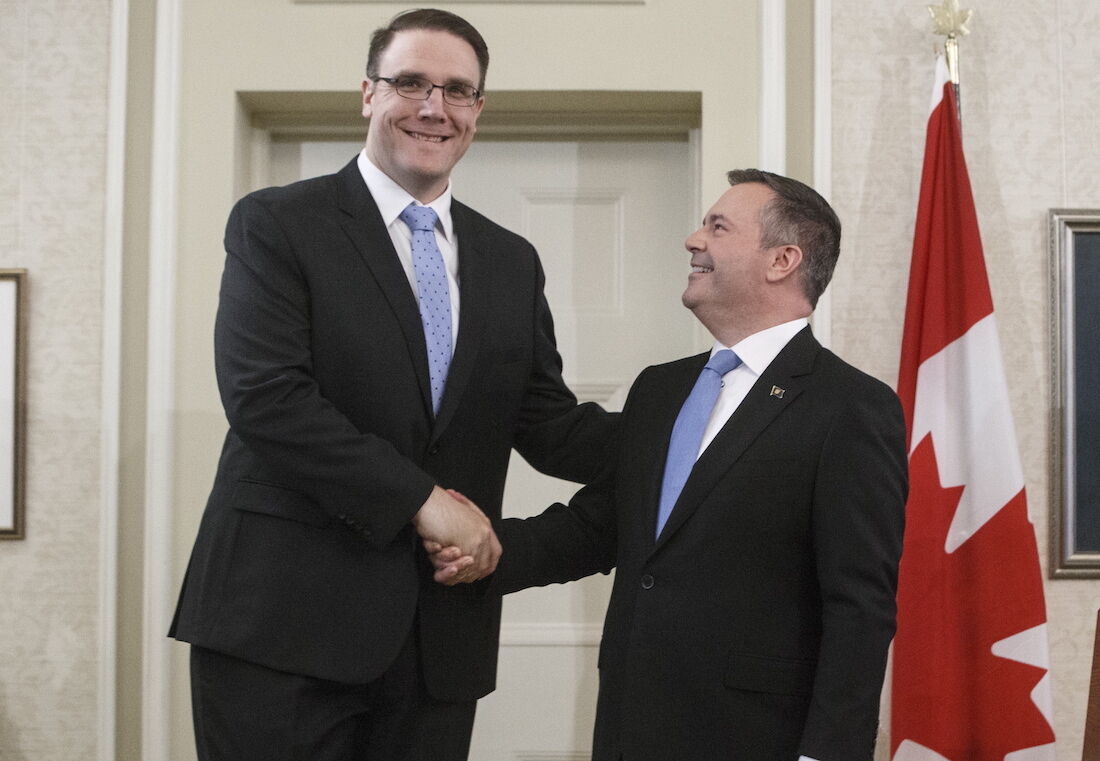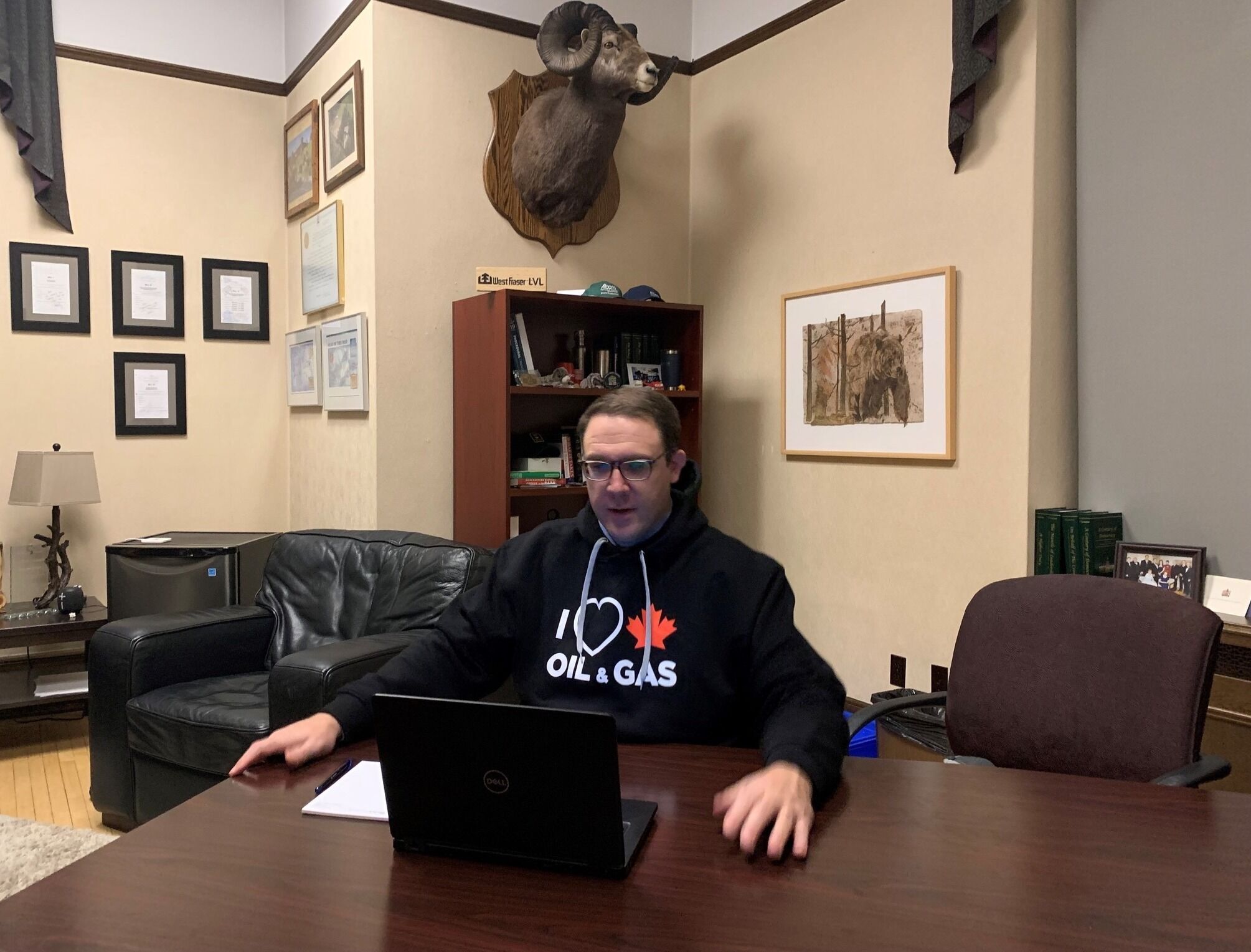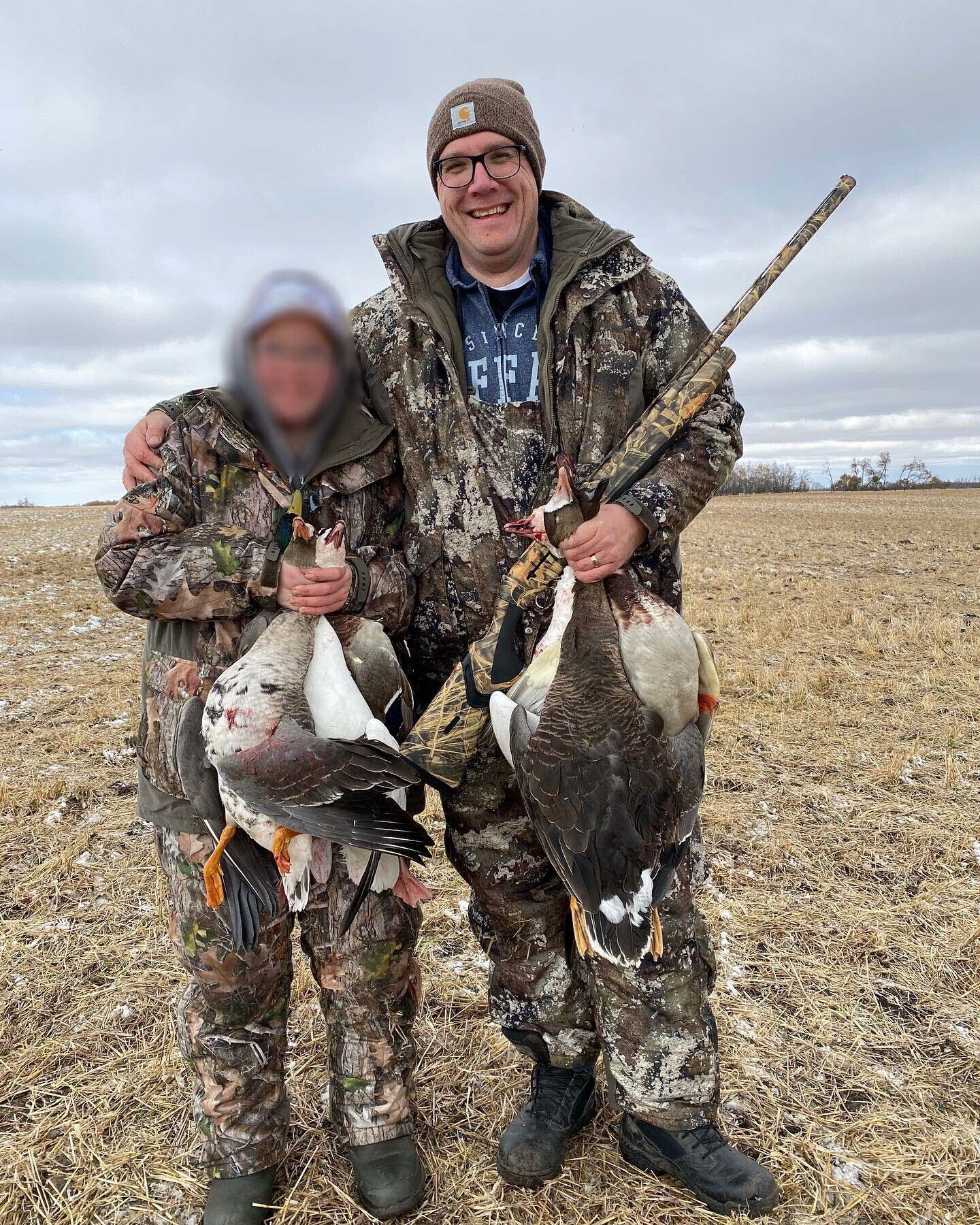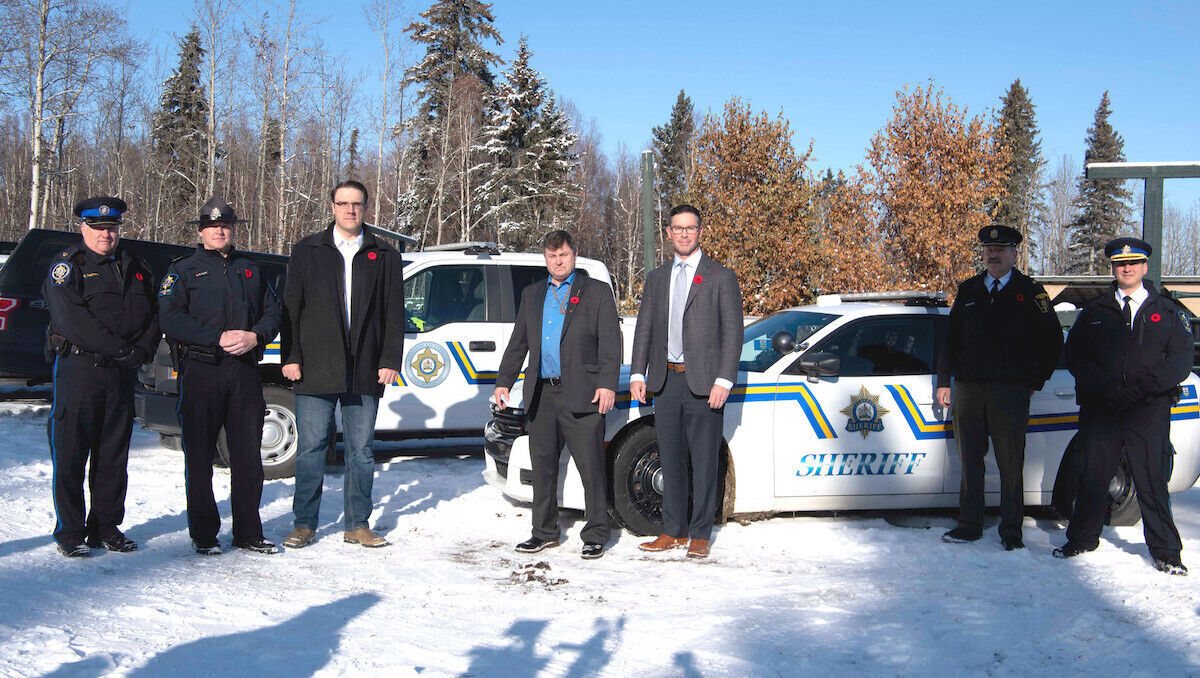
The other Jason: Nixon’s rocky ascent to power
One-time poacher, now environment minister.
Support journalism that digs deep.
Sign Me Up!The Sprawl relies on our readers to make in-depth stories like this possible. With your support, we can keep making our work available to all—no paywalls. If you value slow, independent journalism, become a Sprawl member today!
The Sixty-One Ranch near Cremona is named for the year Allison Gentry’s parents settled there. Set amid rolling hills and running creeks, the picturesque landscape could be on a postcard of the Alberta foothills.
Poaching is a significant problem here. The Gentrys’ land is frequented by wild game, which, despite “no hunting” signs posted frequently along the perimeter fencing, makes it all too appealing for some. The fact that the land is guarded solely by Gentry and her elderly mother only emboldens the men who poach on it.
On November 6, 2009, Gentry drove the perimeter roads, as she and her mother do several times a day, from dawn to dusk, patrolling for poachers. Sure enough, she came upon two men and a boy in a field, about 100 metres from a “no hunting” sign. They had rifles, and were standing over the carcass of a deer. Another man sat in a parked pickup truck.
Gentry pulled over about 30 metres from their truck and rolled down her window. “Gentlemen,” she called out, “you know there’s no hunting on this land!” They appeared to confer, then started walking towards the road. “Are you going to leave it there?” she said, referring to the deer carcass. The group leaned their rifles against the fence and went back to the deer.
Meanwhile, Gentry phoned her mother with a description of the scene and the truck’s licence plate. She also asked her mother to call one of their neighbours. Then Gentry started taking pictures. When the man in the truck saw this, he jumped out and started towards her. “Did I give you permission to take my picture? I didn’t say you could take my picture!”
The man was angry, and, at six-foot-eight, intimidatingly large. It was Jason Nixon.
Back then, Nixon was not a politician, let alone a well-known cabinet minister. To the extent that he was known at all, it was as the eldest son of Pat Nixon, founder of the Mustard Seed homeless shelter in Calgary and an Order of Canada recipient.
Jason Nixon would soon be charged with assaulting Allison Gentry, and with poaching on her land. He would also be charged with threatening and obstructing a Fish and Wildlife officer investigating the Gentry case, and, in a separate murky and high-profile case, killing a horse and careless use of a firearm—all before his 30th birthday.
He would lose his job, and his home, but Nixon would not be convicted on the most serious charges. He began taking courses at Athabasca University, became president of the students’ union, and left a financial scandal in his wake that led to a forensic audit being ordered three weeks after he was elected to the legislature in May 2015.
In 2019, he would be sworn in as minister for Environment and Parks, but he would not leave controversy behind. After nearly three years in the role, Nixon has overseen myriad policies prioritizing resource development over environmental protection, and reduction of government in favour of the private sector. He has advocated for closing parks and lent his ministerial support for coal mining.
His tenure coincides with an era of climate disaster in which scientists are sounding the alarm for urgent action, making Nixon arguably one of the most consequential environment ministers in Alberta’s history, if not Canada’s.
Given that he has become one of Premier Jason Kenney’s most trusted deputies, and is frequently mentioned as a possible successor to the embattled premier, the life and career of Jason Nixon bears scrutinizing—particularly as he has demonstrated a Kenneyesque capacity for self-reinvention, shrugging off past controversies and evolving as needed.

This story is based on court files and other documents, contemporary news reports, and interviews with more than a dozen people who knew or crossed paths with Nixon at various points in his life, including law enforcement, colleagues and schoolmates. Most would only speak on the condition of anonymity, citing Nixon’s history of litigation and intimidation. Others who declined to speak at all mentioned those same reasons.
Nixon did not respond to multiple requests for an interview.
The sources The Sprawl spoke to drew a picture of a man who used his imposing physical stature and family name to intimidate or pressure others. Several expressed surprise at Nixon’s success in politics and his ability to leave behind what they described as a coarser, less polished persona—once pleading guilty to poaching, now minister of the environment.
“He’s a little like his dad,” said someone who knew Nixon during his time with the Mustard Seed. “Really brash, knew what he wanted, very assertive, unapologetic. Pretty gruff, rough around the edges. I think the version you see of him today is the most polished version.”
Jason Nixon's early life
Eighteen months after Pat Nixon was released from prison and four years before he would help found the Mustard Seed, he and his wife Lise had their first child, Jason John Nixon, born in Calgary on May 26, 1980.
Jason and his siblings—Jeremy, Daniel, Ryan, Tyler and Shane—grew up in northeast Calgary. He attended Bishop McNally High School, and played football against another future MLA, the late Manmeet Singh Bhullar.
Nixon met his wife Tiffany in high school. Introducing his family to the legislature in 2015, he said they met while playing laser tag. (“Big target!” quipped an MLA to laughter.)
“As you will see shortly when she stands up, Mr Speaker, in the gallery, there’s a slight height difference,” said Nixon. “She’s about five-foot-two and I’m about five-foot-twenty.”

After a high school romance, they married, had twins in 2006, and Nixon became stepfather to Tiffany’s son Markus, who was born in 1997.
Nixon started a company in 2005 called Nixon Safety Consulting (NSC) that provided workplace safety services and oversight. In January 2006, NSC was named in a complaint made by a former employee to the B.C. Human Rights Tribunal who had been fired by Nixon after she complained about being sexually harassed on a construction site.
The complainant, a 25-year-old mother of three named Kori Harrison, had been hired by Nixon in October 2005 to work as a safety officer during construction of a condominium project in Kelowna called The Lofts. She soon reported being repeatedly sexually harassed by the lead contractor’s project manager, a complaint she made to both the contractor and Nixon. At the urging of the developer, Nixon fired Harrison on December 20, 2005.
In December 2008, the tribunal ruled in favour of Harrison, stating that all the respondents, including NSC, had discriminated against her.
The case was reported on at the time, but found new life when it was dug up by the Edmonton Journal in 2017. Nixon the politician said he was a young and inexperienced businessman at the time, and he didn’t handle the case well. Kenney echoed those comments.
But even after firing Harrison, whom he never met in person, Nixon appears to have taken little interest in her human rights complaint, as noted in the decision.
“NSC participated in the complaint process to a limited extent,” wrote tribunal member Kurt Neuenfeldt. After the lawyer representing the company withdrew from the case in 2006, “no one attended the hearing on behalf of NSC… Further disclosure by NSC would clearly have been of assistance to all the parties, as would Mr. Nixon’s appearance at the hearing.”
The decision ordered the respondents, including NSC, to pay Harrison $15,000 in compensation and $14,144 in lost wages. In considering whether to impose a penalty against Nixon’s company for ignoring the proceedings, Neuenfeldt wrote, “The reality is that NSC is no longer a viable company, and little would be gained from making a costs order against it.”
It’s not clear what portion of the awarded compensation Nixon was responsible for, or whether he paid it. His LinkedIn page makes no mention of Nixon Safety Consulting. His government biography refers to him as having been “an entrepreneur, owning and operating a consulting business for several years.” Corporate records show NSC was struck—meaning it no longer had a legal existence—in 2008 for failure to file annual returns; the company was legally revived in 2011, filed annual returns in 2015, then dissolved in 2016.
“This is still a painful subject for me, but the story will return as Nixon continues his political journey,” Harrison said in a statement to The Sprawl. “I trusted and put my faith in Nixon. I was wrong.
“My job was to protect others and it was ultimately I who needed protection. At trial I held out hope that he would be in my corner, but he did not appear. I wish him well in his endeavours and hope he supports others the way I hoped he would have and should have for my family.”
Nixon charged with poaching and assault
In 1984, Pat Nixon helped found the Mustard Seed—a Christian ministry and outreach organization focusing on the city’s homeless citizens—after growing up in an abusive household and suffering from addiction in his youth. His story is the type of by-the-bootstraps tale of overcoming addiction through personal will and religion often idealized by the right.

This view informed the Seed’s purchase of Mountain Aire Lodge in 2008, a move that was, according to sources, driven by Pat’s vision for a dry-out camp. The idea was to break the cycle of addiction and homelessness by removing individuals from the temptations of the city into a natural setting where they would be able to work and flourish.
Located about 45 km southwest of Sundre as the crow flies, where a gravel road frequented by forestry trucks crosses the Red Deer River, the lodge fit the bill. Jason was given the task of running Mountain Aire, along with his wife Tiffany and other family members.
The surrounding area is beautiful: evergreen forests and grassy hills backgrounded by mountain peaks. Living and working adjacent to pristine wilderness suited Nixon well. He loved the outdoors and was an avid hunter.
He sought to encourage similar passions in his stepson Markus by taking him hunting—or, as on the day he met Allison Gentry in 2009, poaching.
Gentry took me out to where the encounter happened, and the account she gave me there is the same as her statement to police more than 12 years ago. As she tried to take photographs of Markus and the men in the field with the shot deer, Nixon reached through the window of her vehicle, trying to grab her camera. She held it away from him, and he tried to catch her arm to knock the camera away before withdrawing his hand.
When she said that they were poaching, Nixon replied that they had hunting tags, and all they could be accused of was trespassing. As he began walking back to his truck, Gentry’s neighbour arrived. She drove past slowly, taking pictures through her open window. When Nixon saw this, he said, “Oh, now you’re going to take my fucking picture, too?”
As the neighbour drove past him, he made a move to reach through her window, and she accelerated. Nixon laughed and called to one of the men in the field.
“Hey, do you wanna shoot that bitch?”
As the men brought the deer carcass to the truck, Gentry’s neighbour returned and parked behind them. When they saw she was taking pictures, they hurried to load up and leave.
Gentry was keenly aware that she was an unarmed woman alone on a grid road with several armed men whom she’d just found committing a crime, one of whom was yelling and attacking her. But it was not, as they say, her first rodeo.
“Everybody—man, dog and his horse—around here knows that you can’t hunt on Gentry’s,” she told me. “But it doesn’t matter. It doesn’t matter. They’re just like, ‘Those two old bitches aren’t going to catch us... I’m going to get my elk’—because it’s definitely a personal pronoun used in this.”
When the NDP resurfaced the story during the 2019 election campaign, Nixon, Markus and the others denied that he’d made the “shoot that bitch” comment, and said they felt threatened by Gentry, an unarmed woman on a rural road with armed strangers.
Gentry “has been angry for the last 10 years because my son did something inappropriate on her property,” Nixon said. “I chose to pick my twelve-year-old son up and put him in the truck and drive him to meet with Fish and Wildlife authorities.”
I trusted and put my faith in Nixon. I was wrong.
Adam Mirus was the lead Fish and Wildlife officer investigating the poaching allegation. He interviewed Gentry, as well as Nixon and the others, conducting the interviews in his truck, which was equipped for recording video and audio.
But when Mirus returned to Mountain Aire on January 4, 2010, Nixon was displeased with the continuing investigation. His statements during that interview, captured on video, led to him being charged with uttering threats and obstructing an officer.
The video was played in court during Nixon’s trial, but Judge Marlene Graham refused to allow its public release despite a freedom of information request and court case by freelance journalist Britton Ledingham. Graham, who is the former PC MLA for what is now Jason Kenney’s Calgary riding, wrote that “the risk of harm and prejudice to Mr. Nixon outweighs any interest that the public might have in seeing this DVD.”
A description of the video appeared in a March 8, 2011, Mountain View Gazette article. That description was corroborated by a source who has seen the video.
As he was exiting Mirus’s vehicle, Nixon said: “Anytime you want to bring your old lady over here, I’ll service her for you, you dickless fuck. Get the fuck off my property.”
Nixon then said to someone nearby: “I’m going to manhandle this guy in about a minute.”
This last statement resulted in the charge of uttering threats, as Mirus testified that he believed it to be a threat to his safety. Nixon denied this in court.
“I had no intention to threaten him,” he said, according to the Gazette article. “I was trying to have officer Mirus leave.”
Mirus also said in court that he heard Nixon tell staff members not to help locate someone Mirus was looking to interview. This was not captured on the recording, and Nixon denied saying it, but it resulted in a charge of obstructing an officer. He was found not guilty of both charges in June 2011.
At the same time, Nixon pleaded guilty to the poaching charge and was sentenced to pay a $500 fine.
Anytime you want to bring your old lady over here, I’ll service her for you, you dickless fuck.
The assault charge involving Gentry was dropped a few months earlier, in February 2011, when Nixon agreed to enter into a peace bond.
Years later, when the NDP brought up the case, he argued that the peace bond was not an admission of guilt, and denied Gentry’s allegations. But while not legally an admission of assault, the peace bond that he literally signed off on is clear in its language: he “caused Allison Gentry to fear that Jason John Nixon will cause personal injury to her, in that [Nixon] did… harm Allison Gentry.”
A dramatic retelling of Nixon's arrest
More than a year before these legal issues were resolved, however, new ones appeared. In January 2010, two weeks after the incident with Mirus and still facing an assault charge from the encounter with Gentry, Nixon was arrested for shooting a horse.
Ten police officers, some with their guns drawn, showed up at his home at the Mountain Aire Lodge. “Get down you big fucking retard!” one officer yelled at him. Fearful of being Tasered due to a heart condition, Nixon complied and laid on the ground. He was handcuffed in front of his two-year-old children and taken to the Sundre RCMP detachment.
That’s the story, at least, as told by Licia Corbella, the longtime columnist and editor for the Calgary Herald and Calgary Sun, who has written extensively about Nixon since well before his political career. This description of Nixon’s arrest appears in a characteristic April 28, 2011 column in which Corbella vigorously defends Nixon and derides his detractors.
That column is one of a number of her columns about Nixon that no longer appear on the Herald’s website. (Several Corbella articles were pulled down in 2019 after the Herald admitted she had failed to disclose to her bosses or readers that she was a UCP member who voted in the party’s leadership race while simultaneously covering it.)
Multiple sources with knowledge of Nixon’s arrest told The Sprawl that Corbella’s description of events is markedly different from what happened.
According to the sources, police first went to the Mountain Aire office to see if Nixon was there. When told he was at his home, the officers made the short drive there. Two RCMP officers knocked on his door while two other officers watched from a police car across the road.
When Nixon answered the door, he was not surprised to see the officers—whom he knew personally—as he’d received a call from the office informing him that they were en route to his home. The officers informed Nixon he was being arrested, and suggested he grab a jacket and any medication he might need. They read him his rights before handcuffing him and leading him to their car.
Nixon was polite and cooperative, according to the sources: No voices were raised, no one laid on the ground, no weapons were drawn.
“Not even close,” said one source, adding about the scene described in Corbella's column: “It’s as far from the truth as you can get.”

Corbella’s description of the arrest featured quotes from Nixon, and appeared again in a 2017 column, but it does not seem to have been corroborated anywhere else. Notably, it was not raised in Nixon’s subsequent civil suit against the RCMP.
In response to a request for clarification regarding this column, Corbella said in an email to The Sprawl that she “received a comment from then RCMP spokesperson at the time, Sgt. Patrick Webb, and sought comment on many aspects of the RCMP’s investigation.” She noted multiple times that Nixon’s lawsuit against the RCMP was settled out of court, and stated that Nixon and the others were “wrongly charged in this case.”
“Nixon’s versions of events have been backed up by witnesses,” she wrote, “whom I interviewed 11 years ago now, and by the courts, that found him and the others not guilty of the charges levelled against them—which is a finding of fact.” (This is incorrect. The courts did not find Nixon not guilty; the charges were dropped before the trial began.)
Monica Zurowski, deputy editor of the Calgary Herald and Sun, said the article was not deliberately removed from the website but was lost in the shuffle of two systems overhauls since its publication 11 years ago. She noted that the column was still available through the Calgary Public Library, as well as paid archival services such as FPInfomart.
The horse incident: What actually happened?
So-called “wild” horses, like the one Nixon was accused of shooting, are considered feral by the government and many experts, on the basis that they are descended from domesticated horses that escaped or were released from industrial operations in the early 20th century (although others dispute both the science and relevance of that argument).
Regardless, they are beloved by many, and in the years leading up to Nixon’s arrest, dozens of horses had been found shot, many of them in the Sundre area, prompting outrage and a $25,000 reward from the Wild Horses of Alberta Society for information leading to a conviction.
In October 2009, after hearing about the reward, a man named Chuck Kollin called the Sundre RCMP detachment with a tip. Kollin said he knew someone named David Goertz who claimed to have been with a group that shot and killed a feral horse. Cpl. Dave Heaslip, a veteran livestock investigator with the RCMP, interviewed Goertz and found his story credible.
Goertz said that he, Nixon, Nixon’s stepson Markus, and two other men from Mountain Aire Lodge were out driving when they spotted some feral horses high on a 10-metre cliff-faced hill adjacent to the road. They stopped, got out of the truck and began shooting. A large black horse was hit several times and fell down to the road, exploding on impact. The group ran over and saw that the horse was a pregnant mare, and her unborn foal had burst out of her.

With dusk setting in, the dead horses lying in the middle of a narrow road were a real hazard. But they were too heavy to move, so Nixon went to the lodge and got a Bobcat to push the bodies off the road and down a steep, heavily wooded cliff towards the river.
Searching the area Goertz indicated, a short drive from Mountain Aire Lodge, investigators found the skeletal remains of a female horse and foal. With little or no tissue remaining, a forensic examination found no evidence of a gunshot wound and the cause of death was inconclusive. But Heaslip still believed Goertz’s story, and charges were laid a few months later.
The other men charged were Gary Cape and Earl Anderson, former clients and now staff members of Mountain Aire. A 13-year-old boy was also charged but not publicly named as required by law; however, Corbella identified the boy in multiple columns as Markus Nixon, Jason’s stepson, which sources and court records confirmed.
More than a year later, in 2011, with the well-publicized trial about to begin, four hunters came forward with a different story.
They said they were out driving that day when they came upon the body of a horse lying on the road below a steep cliff. The horse was clearly pregnant, and the body was still warm. They reasoned she must have fallen and died.
As luck would have it, one of the four was studying veterinary medicine. He decided to attempt an emergency Caesarian section to save the unborn foal. But the foal was also dead, and now there was a gruesome scene on the road. Recognizing the hazard, the men pushed the horses as far off the road as they could before leaving.
Fortunately for Nixon and the others, the hunters took photos of the dead horse, both intact and after she had been cut open—which was how Nixon’s group found her.
The crown dropped the charges.
Corbella took Nixon on a victory lap, deriding the RCMP as “Keystone Kops.”
“The new evidence not only proves Nixon and the three co-accused are innocent of the heinous charges they were accused of, but has exposed the misconduct of the RCMP and its eagerness to believe an outrageous story dreamed up by David Goertz, a longtime crack and crystal meth addict seeking a $25,000 reward over the reputation of a law-abiding family man running a Christian ministry,” wrote Corbella.
Corbella neglected to mention that the “law-abiding” Nixon had only recently signed a peace bond to have assault charges against him dropped, was facing a poaching charge to which he would soon plead guilty, and was soon going to trial on charges of threatening and obstructing an officer.
He was also no longer running a Christian ministry, having been let go from his position at Mountain Aire. The exact details of how he and the Mustard Seed parted ways remain unclear. But multiple sources with knowledge of the situation said that it became a source of tension between Pat Nixon, who retired at the end of 2010, and the Seed’s board of directors.
In September 2011, Nixon, Markus, Anderson and Cape filed a lawsuit against the RCMP for more than $1 million each, claiming the negligent investigation had caused them significant harm and reputational damage. To bolster their claims, they commissioned a former Ontario Provincial Police officer, Jeff Bahm, to investigate the RCMP’s investigation. His report is scathing and at times incredulous at what he considered poor police work.
[Allison Gentry] has been angry for the last 10 years because my son did something inappropriate on her property.
One example is that Nixon, after his arrest, was questioned multiple times but no video or audio recordings of those interrogations were made, which Bahm wrote was “certainly not the standard practice or the general norm of police services in Canada.”
Bahm even travelled from Ontario to visit the scene himself, which led him to determine that “the incident could not have occurred as described by David Goertz.” He believed the high cliff above the road “would have totally blocked the shooter’s vision of the open ridge,” making it an impossible shot.
Bahm’s report states that the RCMP were too credulous of Goertz’s claims, given that he was clearly interested in claiming the $25,000 reward.
The report also highlighted several times that the two accusers “were both homeless,” and that one of them acknowledged “having a crack cocaine and alcohol addiction and had used crack cocaine only days before the interview with Cpl. Heaslip.” This trope, which Corbella also deploys in several columns defending Nixon, seems ironic given the Mustard Seed’s ethos of compassion and Pat Nixon’s own history battling addiction.
The civil suit against the RCMP was settled out of court by arbitration, and there are no public records of the details of that settlement.
Entering politics: A minor scandal at Athabasca University
Losing his job at Mountain Aire also meant Nixon and his family had to find a new home, and they settled near Sundre. Jason began upgrading his business diploma from SAIT, taking remote classes at Athabasca University, a distance learning school. This would also be his first foray into elected office.
He was elected to the students’ union executive, first as vice president of finance in April 2012—seven months after he launched his million-dollar civil suit against the RCMP—and then as president in 2014.
His tenure with the Athabasca University Students’ Union (AUSU) would overlap with his entry into provincial politics, and at every step Nixon would stir controversy.
In the fall of 2013, Nixon became the president of the Wildrose Party constituency association for the riding of Rimbey-Rocky Mountain House-Sundre. The incumbent MLA, Joe Anglin, had run for the Alberta Green Party in 2008 and was its interim leader prior to the party’s dissolution. Anglin defected to the Wildrose for the 2012 election, defeating longtime PC MLA Ty Lund.
Nixon was elected AUSU president in February 2014. In June, two months after starting that new job, he took a leave of absence from his role as constituency association president and filed his papers to seek the Wildrose nomination—an abrupt and direct challenge to Anglin, his own party's MLA. “I thought he was on my side and we were working together,” Anglin told the Edmonton Journal at the time. “It was a real shocker. Welcome to politics.”
The Rimbey Review called Nixon “an unlikely candidate”. But the following month, he won the nomination.
On October 15, at the annual general meeting for the Wildrose constituency association, Nixon and his supporters reportedly stormed out, while Anglin and his supporters proceeded to elect a new board of directors—prompting Nixon’s side to call foul, saying that the meeting had ended when they left and there was no new board.
This incident, which Anglin described as a “kerfuffle,” only deepened existing divisions.
An independent review reportedly concluded that the entire meeting, including the vote on directors, was invalid due to bylaw infractions and “unacceptable behaviour that forced the chairman to adjourn the meeting early.” Anglin would quit the Wildrose in November to sit as an independent for the rest of his term, citing an “internal civil war.”

When Premier Jim Prentice called an election a year earlier than expected, Nixon hit the campaign trail. But he continued to receive his AUSU salary for nearly two more weeks before he took an unpaid leave of absence from that position.
Nixon’s compensation from the students’ union would prove controversial, even after he left.
When the AUSU council voted to fire longtime executive director Tamra Ross in October 2014, their bylaws stated that the president should cover that vacancy on an interim basis until a replacement was found. Nixon’s $36,400 salary as president was thus replaced with that of the executive director, which two sources confirmed was in the $90,000 range.
He was still collecting that salary almost half a year later when he went on leave to run in the provincial election.
A members’ motion put forward at the 2015 AUSU annual general meeting called for a forensic audit examining recent executive compensation increases, and specifically the many questions around Nixon’s pay. That report, completed in February 2016, questioned the lack of documentation of decision-making regarding the executive director vacancy and change in Nixon’s compensation.
It expressed concern with the “significant” salary Nixon received, and highlighted the fact that it took nearly six months to fill the executive director role.
“The decision to change Jason Nixon’s compensation to that of the executive director was made by executive with no documentation and no reference to council input or policy direction,” wrote the audit committee.
Nixon received the executive director salary for five and a half months while the position remained unfilled, from November 2014 to April 2015. He went on leave beginning April 20, with another councillor stepping in as interim president. One week later, a new executive director was hired: the AUSU’s office manager.
Off to Edmonton as a Wildrose MLA
On May 5, a political earthquake struck: Rachel Notley’s NDP won a majority government with support across the province, ending the PC dynasty and shattering notions of what was possible in Alberta politics.
Nixon’s election wasn’t particularly noted outside of his riding and circles of political nerds following his conflict with Anglin. His seat was Wildrose before, and Wildrose after.
In April 2016, as the “unite the right” idea that sprung up after the NDP’s victory gained serious traction among conservatives, Nixon put out a statement calling the idea of forming a new party “folly.” The future, he insisted, was his own party.
“Wildrose will continue to have grassroots discussions with principled conservatives about becoming an even broader and more inclusive big tent party,” he said. Ironically, Nixon would not only play a role in the merger negotiations between the Wildrose and PCs, he would become a close lieutenant of the man who would soon be westbound to unite Alberta conservatism—Jason Kenney.
When Kenney selected his first cabinet after the UCP’s 2019 election, he rewarded those who had supported him, and who were on his side of the ideological spectrum within the party. Nixon had endorsed Kenney for the leadership rather than Wildrose leader Brian Jean, and served as the Opposition Leader in the legislature until Kenney won a seat in a by-election. Having earned his leader’s trust, Nixon was handed the high-profile portfolio of Environment and Parks. (The 2019 election also saw his brother Jeremy first elected as the MLA for Calgary-Klein.)
It no doubt helped that he had some political experience, given the large number of first-term UCP MLAs. Of 19 ministers in Kenney’s cabinet, Nixon was one of only four who had served at least one previous term. (The others were Prasad Panda—who was technically elected in a byelection a few months after the 2015 election—Leela Aheer and Ric McIver.)
Environment and Parks was even more high-profile than usual: In an era of worsening climate change, the UCP had won power with a mandate to fight environmental groups, scrap the NDP’s carbon tax, and champion the province’s extractive industries, particularly fossil fuels.
Nixon got to work quickly. One week after being sworn in as minister, he cancelled the NDP’s plan to protect the Bighorn region.
I thought he was on my side and we were working together.
It was hardly a shock. Nixon’s riding included the Bighorn, and he’d spent much of his first term championing the outrage of many of his constituents at any perceived attempt to change or restrict the way they used the land. This aligned with the UCP’s overall campaign strategy to depict the NDP as radicals out to destroy Alberta.
When, in November 2018, NDP environment minister Shannon Phillips announced the government’s plan to create what the Edmonton Journal called “west-central Alberta’s long-overdue answer to Kananaskis Country,” many locals who had made use of the Bighorn backcountry bristled.
In particular, snowmobile and off-highway vehicle users saw the conservation effort as a threat to their long-standing use of the area.
Nixon certainly stoked those fears, and others. A Globe and Mail story summed up his position: “Mr. Nixon has asserted, without evidence, that the plan is a foreign-funded plot to wall off the back country to Albertans who call the region home.”
“We all agree with protecting the environment,” Nixon said in a statement, “but this NDP government has been all too willing to sacrifice jobs for their own ideological goals.”
Nixon repeatedly asserted that the NDP had failed to consult with Albertans, and he doubled down on his rhetoric after several regional town halls were held as phone conferences rather than in-person events following reports of threats and harassment.
In fact, the Bighorn plan did not originate with the NDP, but years earlier under the Progressive Conservatives. Polls showed a clear majority of Albertans favoured the plan.
'Optimizing' parks and embracing coal
Nixon wasn’t opposed only to the creation of the Bighorn parks—he thought some of the province’s existing parks ought to go, too.
On February 29, 2020, one day after the provincial budget slashed funding for public parks, the Optimizing Alberta Parks plan was released. It outlined a vision for the parks system that saved money by fully or partially closing 20 parks, and shifting 164 others out of the park system into “partnerships” with the private sector.
Public outcry was swift and fierce. Coming after the UCP had made controversial privatization moves in health care and other sectors, many Albertans were upset over the logic of markets extending to outdoor spaces. Defend Alberta Parks, a campaign organized by CPAWS and the Alberta Environment Network, began distributing lawn signs, which were soon a common sight.

“I could have told them that Albertans really love their parks and outdoor spaces, and value the things that come with that, whether it’s wildlife or clean water or just access to the outdoors,” said Katie Morrison, executive director for CPAWS Southern Alberta chapter.
“It wasn’t really a surprise to me that Albertans reacted the way they did because we know that people value those things.”
When documents released under freedom of information legislation showed that Nixon’s office overruled the advice of senior civil servants by refusing to do public consultation prior to implementing the plan, the NDP was quick to label Nixon as “intensely hypocritical.”
“Before the election, Jason Nixon dined out on the fact that after 10 years of consultation on Bighorn we still hadn’t consulted enough,” said Notley. “Jason Nixon doesn’t have a leg to stand on.”
In December 2020, Nixon and the government backed down, announcing that none of the parks would be closed.
Nixon’s tenure has also been marked by his support of coal development. In May 2020, the government abruptly removed decades-old restrictions on open-pit coal mining on the sensitive Eastern Slopes of the Rocky Mountains, calling it “redundant.” In a statement, Nixon said the government was “striking the balance of ensuring strong environmental protection with providing industry with incentive to increase investment.”
By doing nothing from a policy perspective on climate change, he’s been very consequential.
Months before that, Nixon was lending his support for a foreign company looking to open just such a coal mine in Alberta.
Australia-based Valory Resources pitched potential investors on its Blackstone project, a 16,000-hectare open-pit mine near Bighorn country. A PDF presentation lists the advantages of the project from the company’s perspective, including the quality of the coal, access to transportation and a “supportive provincial government.” But investors needn’t take the company’s word for it: Letters of support from Nixon and Tanya Fir, minister of Economic Development, Trade and Tourism, were included as well.
Despite holding portfolios with ostensibly different priorities, the ministers’ letters were remarkably similar. Both express support for the project, and both mention investment in the province (Nixon uses the word “invest” five times to Fir’s one). Both highlight “cutting red tape” and “efforts to streamline” regulatory processes.
The only time Nixon uses the word “climate” is in discussing the province’s “investment climate.” The word “environment” appears nowhere in the letter, even avoiding it in his sign-off: “Jason Nixon, Minister.”
“The only thing in there that indicates he’s minister of the environment is the letterhead,” said Ian Urquhart, executive director of the Alberta Wilderness Association.

These are only the highlights of Nixon’s ministerial tenure—there’s also the Trails Act, allowing logging of caribou habitat, and much more.
But his most significant impact might actually be what he hasn’t done.
“By doing nothing from a policy perspective on climate change, he’s been very consequential,” said Urquhart. “He is the most consequential [environment minister] by being the least consequential.”
Nixon's next move
Kenney faces a leadership review on April 9, and with massive registration and a controversial switch to mail-in ballots, all bets are off. The party’s base has become more radicalized over the course of the pandemic, and Kenney has been combating open revolt in his caucus. Though Brian Jean has emerged as a prime foil, Kenney has no obvious heir apparent, resulting in much speculation in which Nixon’s name invariably arises.
Some sources who spoke to The Sprawl, even those who were critical of Nixon, acknowledged he is a natural leader. He is polished enough to regularly speak on behalf of the government in the Legislature as House Leader, but not so much that he alienates his mostly rural, mostly conservative constituents.
I will not rule out that I will ever run for leadership.
Asked in 2017 if he would seek the leadership of a then-hypothetical new party, Nixon demurred. “I don’t think I am running for leader in the next election, although I will not rule out that I will ever run for leadership. It’s a possibility for one year, but I don’t think it will be for the 2019 election.”
That intra-party tension appeared in Nixon’s riding in the form of Tim Hoven, a farmer from Eckville whose Twitter account is awash with support for the Coutts blockade, memes about personal freedom and retweets of Ezra Levant. Hoven launched a challenge for the riding’s UCP nomination with Jean’s endorsement, but was recently disqualified by the party for what it said was “a pattern of activity that would bring disrepute to the party,” including following white nationalists on the far-right social media platform Gab. Hoven’s appeal was rejected, eliminating the only threat to Nixon’s re-nomination.
That Jason Nixon might be considered by some party faithful to be too moderate speaks volumes about the state of the UCP. The same dynamic applies to Kenney’s leadership review: while the premier insists the UCP is “mainstream,” the base is determined to pull their leaders towards the fringe. How the party will navigate this internal divide is an open question—as is, at the moment, who will be leading that effort.
“I do think that Jason is the type of guy who has gotten really far by aligning himself with the right people,” said a person familiar with Nixon’s tenure as the Athabasca University students’ union president. “He somehow figures out how to put himself in the right place. He did that with AUSU. He’s very convincing. He’s a great politician, I’m sure.”
Taylor Lambert is a freelance journalist based in Calgary.
CORRECTIONS: This story originally stated that Mountain Aire Lodge is 45 km southeast of Sundre as the crow flies; in fact, it is 45 km southwest of Sundre. This story also originally stated that in 2017 the NDP dug up the human rights complaint against Nixon's old company; in fact, the Edmonton Journal dug it up, and the NDP followed up on this reporting. The Sprawl regrets the errors.
Support journalism that digs deep!
Sign Me Up!The Sprawl relies on our readers to make in-depth stories like this possible. With your support, we can keep making our work available to all—no paywalls. If you value slow, independent journalism, become a Sprawl member today!



